PoliceMonkey161
New member
Fabricating Floor Boards and Overlays with Sheet Metal or Tread Plate<O ></O
></O >
>
In this article we will cover how to make rear floor boards or overlays for a CJ using aluminum tread plate. You could apply this method to create virtually any sheet metal part that you need out of whatever material best suits the situation. We are going to make floor board overlays from tread plate, but you could just as easily make replacement floor pans, body patch panels or other decorative panels the same way. You don’t really need a bunch of expensive tools, this project can be completed with basic tools, time and patients.
We’ll start by identifying the part we want to make, in this case, rear floor board overlays. Since my project is a frame off restore, I did not have much area to clean up or too much stuff to remove. Here’s something to keep in mind, on the CJ tub, the transmission tunnel and driveshaft relief are not directly in line with the centerline of the vehicle. In other words, the passenger’s side floor boards are slightly wider than the driver’s side because the transmission tunnel is off-set slightly towards the driver. So, on my project, I shortened the passenger’s side and the driver’s side overlays equal distance from the trans tunnel to give the appearance of symmetry.
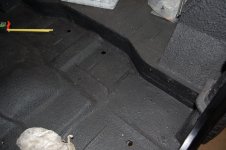
Next, cut up some strips of cardboard in various lengths by 1.5 to 2.0” wide which we’ll use as our “mock up”. You want to fit the strips along the edges of the area to be covered, cut length wise to conform to the contours.
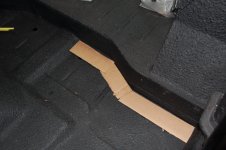
Once you have made the outline of the area using the cardboard, use masking tape to connect the individual strips together. In this case, I used support pieces (marked “A,B and C”)to provide structural integrity so the mock-up can be moved from place to place. You can also fill-in any areas of the mock-up that have gaps or don’t quite fit using masking tape at this point.
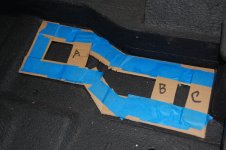
Once you’re certain that the mock-up piece fits to the desired shape, you can transfer the mocked up outline to a flat piece of cardboard and cut it out with a razor knife. Afterwards, check that your cut-out fits properly into the project area.
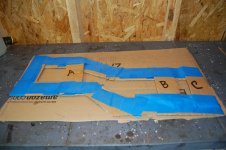
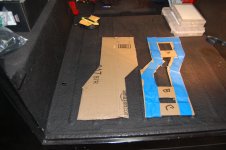
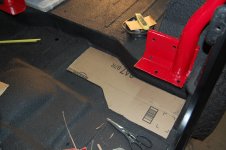
Now we can transfer the outline of the cut-out to the sheet metal. Since I’m using diamond tread, a grease pen (or crayon) is the best choice since it can easily be clean off the finished surface. I have also marked the “non-finished” pieces of our sheet metal with “X’s” so I know which areas it would be OK to cut over into or make stress cut into. Keep this in mind: if you are use sheet metal with a finished side (like the diamond plate), you’ll need to trace your outline to the finished side or tracing to the backside your piece will be inverted! In this case of the rear pans, it makes no difference as the inverted piece works on the opposite side floor (passengers side) but still I trace one to the finished side and one to the backside of the sheet metal so I have matching pieces afterwards.
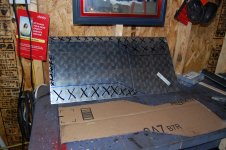
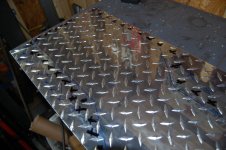
Now you’re ready to cut out the fabbed piece. I always cut to the outside of my lines and trim my pieces to fit especially since for this project I’m using a plasma torch. But you could cut these out just as easy with a cut off wheel, grinder w/ cutter wheel or even a hack saw (it will be time consuming, but it will work just the same). If I were just making patch panels (for the tub, fenders or floor boards)from common sheet metal, I could use tin snips or sheers but they will distort the metal a little too much for this project. Regardless of how you do the cutting, you will need to file down the sharp or rough edges.
You likely need to do some minor fitting to get the finished piece in. On this project, I had to do a little filing but mostly to remove the sharpen/rough edges. You can now attach the piece whichever way you would like(blind rivets, screws and if its a patch panel, weld in).
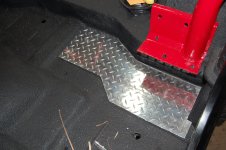
Lastly, you’ll need to re-install any of the fixtures that you removed. In this case it’s the YJ roll bar which needed a little modifying to fit the CJ tub anyway.
<O
![IN%206[1].JPG IN%206[1].JPG](https://www.jeepz.com/forum/data/attachments/17/17242-8a2b192424e8297769044ab896de7c75.jpg?hash=iisZJCToKX) </O
</O
Last edited:
